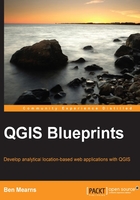
What this book covers
Chapter 1, Exploring Places—from Concept to Interface, gives you an overview of the application types and technical aspects that will be covered and how QGIS will be leveraged. through a simple map application example from the digital humanities. You will use some fundamental GIS techniques to produce a tile cache-leveraging web application that includes geocoded addresses, joined data, and a georeferenced image.
Chapter 2, Identifying the Best Places, will look at how raster data can be analyzed, enhanced, and used for map production. You will produce suitability grids using map algebra and export to produce a simple click-based map.
Chapter 3, Discovering Physical Relationships, will create an application for physical raster modeling. We will use raster analysis and a model automation tool to model the physical conditions for some basic hydrological analysis. Finally, you will use a cloud platform to enable dynamic query from the client-side application code.
Chapter 4, Finding the Best Way to Get There, will explore formal, network-like geographic relationships between vector objects. You will learn to create a few visualizations related to optimal paths: isochron polygons and accumulated traffic lines. The end result will be an application that will communicate back and forth with your audience regarding safe school routes.
Chapter 5, Demonstrating Change, will demonstrate visualization and analytical techniques to explore relationships between place and time and between places themselves. You will work with demographic data from a census for election purposes through a timeline controlled animation.
Chapter 6, Estimating Unknown Values, will use interpolation methods to estimate unknown values at one location based on the known values at other locations using the NetCDF array-oriented scientific data format. You will use parameters such as precipitation, relative humidity, and temperature to predict the vulnerability of fields and crops to mildew.
Chapter 7, Mapping for Enterprises and Communities, will use a mix of web services to provide a collaborative data system. You will create an editable and data-rich map for the discovery of community information by accessing information about community assets.